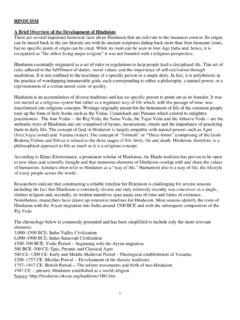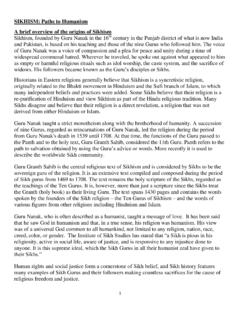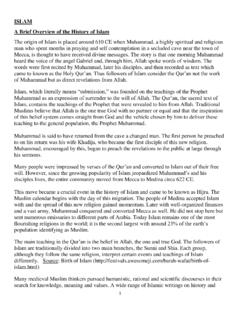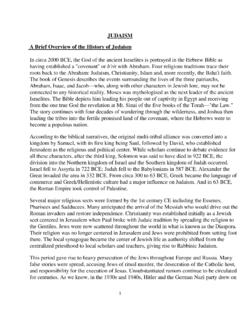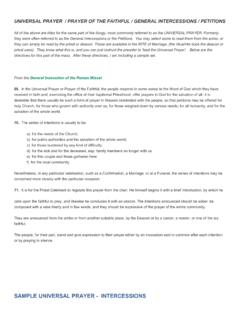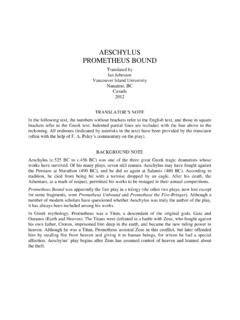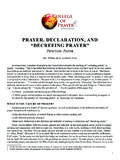Transcription of PAGANISM A brief overview of the history of Paganism The ...
1 1 PAGANISM A brief overview of the history of PAGANISM The term Pagan comes from the Latin paganus which refers to those who lived in the country. When Christianity began to grow in the Roman Empire, it did so at first primarily in the cities. The people who lived in the country and who continued to believe in the old ways came to be known as pagans. Pagans have been broadly defined as anyone involved in any religious act, practice, or ceremony which is not Christian. Jews and Muslims also use the term to refer to anyone outside their religion. Some define PAGANISM as a religion outside of Christianity, Judaism, Hinduism, Islam, and Buddhism; others simply define it as being without a religion.
2 PAGANISM , however, often is not identified as a traditional religion per se because it does not have any official doctrine; however, it has some common characteristics within its variety of traditions. One of the common beliefs is the divine presence in nature and the reverence for the natural order in life. In the strictest sense, PAGANISM refers to the authentic religions of ancient Greece and Rome and the surrounding areas. The pagans usually had a polytheistic belief in many gods but only one, which represents the chief god and supreme godhead, is chosen to worship. The Renaissance of the 1500s reintroduced the ancient Greek concepts of PAGANISM . Pagan symbols and traditions entered European art, music, literature, and ethics.
3 The Reformation of the 1600s, however, put a temporary halt to Pagan thinking. Greek and Roman classics, with their focus on PAGANISM , were accepted again during the Enlightenment of the 1700s. PAGANISM experienced another rise in the 1800s and 1900s when modern forms of Buddhism and Hinduism were growing in popularity. Following the interest in ancient civilizations that became popular in the 17th through 19th centuries, including the popularity of the Druid revivals, scholars in the early 20th century explored the ancient spirituality of the British Isles and Europe. The more current Pagan Renaissance grew out of a variety of sources that coalesced between the 1930s and 1950s.
4 PAGANISM represents a wide variety of traditions that emphasize reverence for nature and a revival of ancient polytheistic and animistic religious practices. Some modern forms of PAGANISM have their roots in the 19th century, , the British Order of Druids, but most contemporary Pagan groups trace their immediate roots to the 1960s and have an emphasis on a spiritual interest in nature. PAGANISM today is a movement that consists of many different perspectives. Most American pagan religions have practices that blend different traditions such as Celtic, Greco-Roman, Native American, ancient Egyptian and Norse. Pagan traditions draw from ancient beliefs as well as from modern beliefs formed in the last century.
5 For example, PAGANISM found an ally in the ecological and feminist movements of the 1960 s and 70 s. Pagan philosophies appealed to 2 many eco-activists who also saw nature as sacred and recognized the Great Goddess as Mother Nature. Recommended readings PAGANISM : An Introduction to Earth-Centered Religions by Joyce and River Higginbotham; Llewellyn Publications; first edition, 2002. Presents the fundamentals of PAGANISM . It explores the Pagan sacred year, rituals, and Pagans beliefs about God, worship, human nature, and ethics. Drawing Down the Moon by Margot Adler; Penguin Books; Revised edition, 2006. An updated resource guide of newsletters, journals, books, groups, and festivals as well as an in-depth look at the beliefs, experiences and lifestyles of modern America's Pagan groups.
6 The Triumph of the Moon by Ronald Hutton; Oxford University Press, 2001. This book has been described as bringing witchcraft out of the shadows. While it explores the dark side of witchery, it stresses the positive, reminding readers that devotion to art, the natural world, and femininity are central to the practice of Wicca. The Basic Beliefs of PAGANISM Because of the wide diversity in PAGANISM , there are a variety of resources about its basic beliefs. In general, Pagans celebrate nature and spirituality and encourage an eco-friendly lifestyle. Equality of the sexes is dominant. Women play a significant role in ceremonies and goddesses are of great importance. Pagans believe that there is divinity in the living world and, through rituals, they can connect with the divine.
7 The festivals are related to their devotion to nature; , the Summer Solstice celebrates the sun and the divinity that creates life. Source: PAGANISM : Types of Religion ( ) The following three items, taken together, provide a comprehensive overview of the basic beliefs. (1) Basic Principles of PAGANISM . Although principles vary from one pagan religion to another, most pagan religions follow the same general set of principles in some form. -- Responsibility of Beliefs. The most basic tenant of PAGANISM is that it is your own responsibility, not the responsibility of any government, institution, church or other people to choose what you believe in regards to spirituality, values, ethics, the nature of Divinity, etc.
8 -- Personal Responsibility for Your Actions and Personal Development. The development of your personal beliefs, morals and ethics is your own responsibility .. it is the responsibility of each individual to learn to recognize what is right from wrong, regardless of our early environment. -- Everything is Sacred. Most pagan religions believe that everything in the universe is sacred, but the definition and level of sacredness applied to an object will generally vary from one pagan to another. For some pagans, all parts of our universe are considered divine and, as such, sacred and worthy of our deepest respect. -- Freedom of Choosing Deity. In all pagan religions, it is up to the individual to determine 3 what Deity means to them, who or what Deity is right for them and how they ultimately develop their relationship with their chosen Deity.
9 Pagans have many different ideas about what encompasses Deity and how their Deity is represented. It is up to the individual, through study of their religion, meditation and, in some cases prayer , to determine what image of Deity is right for them. -- Scope of Consciousness. Many traditional pagans believe that consciousness extends far beyond the restraints of human form and physical existence. All life forms contain some level of consciousness, from the smallest insect to the giant redwood survives death and exists simultaneously on multiple levels of reality. Since the term PAGANISM is something of an umbrella term, used to cover a wide range of spiritual paths, it would be virtually impossible to provide a detailed and comprehensive list of principles that apply to all pagan religions.
10 For the most part however, these very basic principles can be found in almost all forms of PAGANISM . Source: What are some of the basic principles of PAGANISM ? ( ) (2) What Contemporary Pagans Believe . The central beliefs of modern Pagans differ in specifics yet share many fundamentals. Deity is seen as immanent rather than transcendent. Experience is preferred over doctrine. It is believed that there are and should be multiple paths to the there is no set of beliefs shared by all Pagans, most would agree that similarities far outweigh differences. There are a number of beliefs held by the vast majority of modern Pagans. For example: -- Multiple paths to the divine exist as symbolized by many goddesses and gods.
